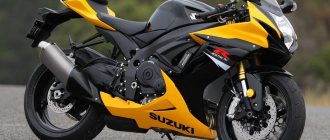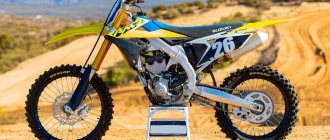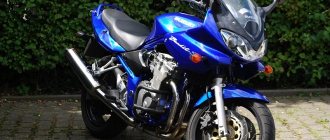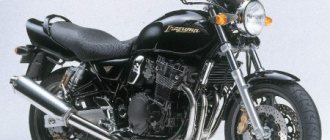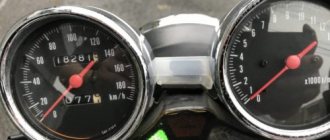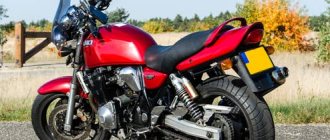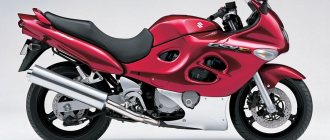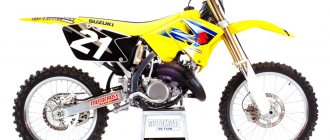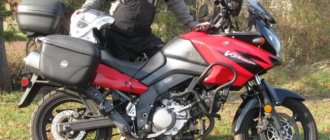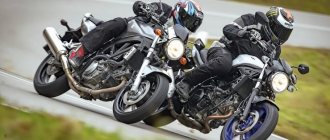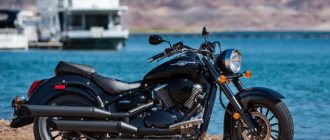The legendary Suzuki GSX R-750 has been shaking roads around the world since the mid-80s. It was then that the Suzuki company took an unprecedented step by releasing a civilian sportbike , developed on the basis of racing motorcycles. At that time, championships were still held in the capacity of up to 750cc, so other Japanese companies took up the initiative. Competition forced Suzuki to continue to develop the model, and now the Jixer is the only one of its kind, because all other participants dropped out of the race after the cancellation of the world championships in 750 cc.
Design
Since the release of the first GSX750R, the model has already gone through a dozen restylings, but each generation of the motorcycle corresponded to the spirit of its time. The first copies look alien in modern realities, but the latest generations were designed by leading designers, and they look great. The generation currently in production was released in 2011, and we can expect another update in the coming years. There have been no significant design changes since 2007, when the GSX R 750 K7 was released.
Specifications
In modern realities, the GSXR 750 remains the only intermediate-sized sportbike, although there are classics and streetfighters with similar technical characteristics. But both them and the Suzuki sportbike can only be recommended for fairly experienced pilots . High power requires honed skills, a cool head and responsibility. However, the Suzuki GSX 750's technical characteristics are generally well balanced, so you can quickly get used to the bike.
Engine
The first Jixer engines used air-oil cooling, but it was decided long ago to abandon it in favor of liquid cooling. In 2008, the S-DMS (Suzuki Drive Mode Selector) system appeared as an additional option, allowing you to choose from three engine operating modes. On the last two generations, the 749 cc 16-valve engine produces 150 hp. power and 86.3 Nm of torque available at 11,200 rpm . The maximum speed of the GSX 750 reaches 280 km/h , and it accelerates from 0 to 100 km/h in 3.08 seconds .
Transmission
The six-speed transmission has undergone many changes over the past decades. It works properly, a little rough, but it's easy to get used to after a few days of driving. But it is trouble-free, problems with it are extremely rare. The efficiency of the transmission has increased even more since 2006, when, along with the new engine, the sportbike received a slipper clutch.
Chassis and brakes
"Jixers" have always been equipped with light alloy frames , which reduced the weight of the motorcycle. The latest generation Suzuki GSX R750 has a curb weight of only 190 kg , and a dry weight of even less, and this is an excellent indicator. The brakes are also decent, especially since 2008 when Japanese engineers began installing the new Brembo braking system . Early examples had problems with the effectiveness of the brakes - there were objectively not enough of them on the track, but this is far in the past. As well as rigid suspensions, since the Suzuki GSX 750 has long acquired a fully customizable chassis, which can be easily adjusted in garage conditions. The last update took place in 2011, when, along with a new Showa fork, the sportbike received a new frame with a pendulum.
Electronics
The latest generations of Suzuki bikes have become noticeably more technically complex. For full diagnostics, you need to connect a laptop with special software to the motorcycle via a bus, which is available only from dealers. But the old “Jixers” are equipped with a minimal amount of electronic filling, and any motor electrician can easily understand them.
Weight and dimensions
Suzuki engineers managed to achieve their goal and reduce the weight of the motorcycle to a virtual minimum. The Suzuki GSX 750 weighs comparable to the 600 and has similar dimensions, while possessing the dynamics of a “liter” sportbike. This provides it with significant advantages both in the city and on the track, and this is why the GSX-R 750 is loved by hundreds of thousands of bikers.
Controllability
Having ridden a fresh Suzuki GSX 750, you understand that you won’t be able to find fault with its handling. The bike behaves so predictably on the road, and so obediently does everything the pilot wants, that it can be called a standard in this parameter. But the same cannot be said about the “Jixers” of the 90s - they had their own problems, such as a tendency to wobble and mediocre feedback from the front wheel, especially on roads with poor-quality surfaces.
Fuel consumption
The motorcycle has been equipped with fuel injection since 1998, and the introduction of a fuel injection system has reduced fuel consumption. On modern Suzuki GSXR 750 it averages just under 6 liters per hundred , although there is practically no upper limit - with aggressive driving, consumption increases rapidly . Old carburetor models are noticeably more voracious, and consume 1-1.5 liters more, while at least preferring AI-95. Although some owners of old “Jixers” fill it with AI-92, and, according to reviews, the motorcycles digest it normally.
The lightest model
Suzuki GSX-R400:
- years of production - from 1984 to 1998;
- four-stroke, 4-cylinder engine;
- working volume - 398 cubic meters. cm;
- cylinder, diameter - 56 mm;
- maximum power - 53 hp. With. in 12000 rpm mode;
- six-speed transmission with foot lever shift;
- wheelbase - 1435 mm;
- maximum speed - 180 km/h;
- acceleration to 100 km/h – 5 seconds;
- gas tank capacity - 16 liters;
- motorcycle weight - 152 kg.
The GSX R400 was released in 1984 and was produced for fifteen years. The motorcycle was developed as a reliable medium-power racing bike. The car was equipped with a high-speed engine, suspension in the form of a reverse telescopic fork in front and an effective pendulum at the rear. At the time of release, the four hundredth was the lightest motorcycle in the R series, weighing only 152 kilograms.
Repair and tuning
Owners of the GSX-R 750 will be pleased with the fact that there are enough spare parts for their steel horses. There are both original Suzuki parts on sale and a lot of analogues, which are often not inferior in quality to components sold by official dealers.
Repair
Maintaining old Jixers yourself is not difficult. In recent generations, Suzuki engineers have significantly improved the design, at the same time making it more complex, so for a number of issues you will have to contact authorized dealers. But this trend affects all modern motorcycles and cars.
Spare parts
The selection of spare parts is very large, although the necessary parts are often not available. The problem can be solved by ordering from foreign online stores. This will save your budget, but you will have to wait for delivery, which may take a month or two. Modern Suzuki GSX 750s cost about the same amount to maintain as the old ones.
Tuning
Probably no sportbike in the world has as much tuning as the Suzuki GSX-R750. This is doubly true for previous generations, which were notorious for insufficiently effective brakes with sluggish feedback. Therefore, many sportbikes of this model on the secondary market are sold in a form modified by previous owners, with reinforced brake hoses, new brake cylinders and calipers.
Motorcycle modifications
The first GSX R 750 was a racing bike slightly adapted for public roads. Engineers equipped it with the latest technology - an aluminum frame, powerful brakes with 4-piston calipers, an anti-dive system and much more, which in 1985 was a real innovation. Since then, the sportbike has been continuously improved and refined, but several main milestones can be identified, before and after which the motorcycle is very different:
- 1989. Release of a single-seat racing modification of the GSX-R750R with a retuned engine and all the improvements available at that time.
- 1990. The appearance of an inverted fork instead of the usual “telescope”.
- 1992. Completely new liquid-cooled engine with increased torque and power.
- 1996. Introduction of the Suzuki Ram Air Direct (SRAD) inertial charging system and the appearance of settings for the front fork of the motorcycle. Instances of the next model year were named Suzuki GSX R 750 SRAD.
- 1998. Replacing Mikuni carburetors with an injector, increasing the maximum engine power.
- 2000. Deep reworking of the Suzuki Jixer 750 motorcycle - new wheels, frame, plastic, brakes, exhaust and injector.
- 2004. Generation K4 – modified engine with titanium valves and increased to 147 hp. power, as well as a completely new design.
- 2006. The all-new GSX 750 K6 arrives, with a new frame, transmission and engine.
- 2008. With the release of the GSX 750 K8, the Drive Mode Selector system with three available engine operating modes is introduced for the first time. This is the only difference from the GSX R 750 K7, which went into production a year earlier.
- 2009. The latest generation of “K”, in this case – K9. All newer copies receive the letter L in the name.
- 2011. Weight reduction thanks to a redesigned frame and swingarm, plus a new Showa fork.
TEST DRIVE: Suzuki GSX-R1000 2007 – ABC “Easy as 1-2-3”
“ABC-easy as 1-2-3” is sung by Michael Jackson in the classic hit of his band the Jackson 5. We believe that Suzuki engineers drew their inspiration not from utopian ideas, but from reality. Just like “ABC”, like “1-2-3”, and let’s continue – “4th, 5th and 6th gears” too!
MOTOGONKI.RU, November 27, 2007 — Test drive of Thor Seigen, Photos by Martin Liefeld
Numbers get boring quickly, but try humming the Jackson 5 while switching engine settings with a single button on the dash, and everything will change. In fact, the difference between “A” and “C” is the difference between 185 and 120 hp. 65 extra horsepower is added with just one push of a button, just like turning on the Super Charger in your Thunderbird.
ABC works! But, having tried the ABCA scheme, I realized that this is a completely different story. When you roll your bike out of the garage on a chilly November morning. You’ve already put on your raincoat and thermal underwear, and now you’re thinking about what mode to prefer today so that you don’t experience excruciating pain over the years spent aimlessly... I don’t think there’s any problem with this. I drove a hell of a lot of miles on completely wet pavement in C mode and felt completely comfortable and didn't feel inferior at all.
As you know, Suzuki now makes motorcycles with ride-by-wire technology, which means the engine is fully electronically controlled, and the user is given a choice of riding modes and fuel economy. Suzuki engineers emphasize this to buyers every time they talk about the GSX-R1000.
I liked the “A” and “C” modes, but I haven’t figured out a use for “B” yet. I rode most of the test drive in “A”: acceleration and dynamics of a powerful liter sportbike and all that. The difference is felt from one touch of the button, because between “C” and “A” there is only one click. “C” is for touring or for rain, or if you want to save gas, for example, on long-distance trips. "A" is for everything else. Did I save gas while driving around the neighborhood in "trolling" mode? From a technical point of view, the engine speed was lower, so less gasoline should have been consumed. But in mode “A” I also made a lot of noise at low revs, so I probably saved something here too. So the answer is more likely no than yes.
Mode "A" = full power throughout the entire range. “B” = restrictions at mid-speed, and full “top”. "C" = everything is tight.
This is a pure road test. Ever since I was almost arrested for testing a Yamaha R1 in the summer of 2007, paranoia has not let me go for a long time. I tried to ride either on a track where there were no policemen, or on abandoned country roads (however, for Harley tests this was beyond the eyes!) During the 14 days of test driving this “Jixer”, I regained my confidence and calmness, and also gained experience , how to use K7 safely on your overalls and motorcycle plastic trims.
Mainly, we will be comparing this bike with its ancestor, the K6. And I will tell you that this is correct, because last year I thoroughly studied the K6 and gained respect for it and its features. But more on that later.
Suzuki insist that the K7 is a much better track bike. It is more convenient when you have to keep the gas fully open for a long time, and also, thanks to the softer “middle”, you can open earlier when exiting corners. The arguments are weighty. But the K6's monstrous mid-range pickup was one of the main arguments in favor last year! And then, the GSX-R1000 earned my highest marks as a road bike.
K7 – new bike, 185 hp. and a trimmed “middle”. But it was the middle speeds that were traditionally the main advantage of the GSX-R1000 over the Yamaha R1. We have to admit that the K7 has begun to lose this advantage. Nobody wants to lose horses for a better sound or a new look.
Everything's under control. And that's exactly what I was disappointed with: where was the brutal power that I felt every second of driving the K6? But these were only sensations from the loss of the active “middle” of the tachometer. The K7 quickly picks up speed and at the “top” the engine output is much more impressive. The dynamics are noticeable, especially on the highway.
The response to the throttle is constant without any dips, the “smart” injector is controlled by an electronic throttle, and that’s great! I think that in 2009 Suzuki will come up with something even more incredible.
The suspension and chassis are also noticeably improved, and more importantly, they remain true to the Jixer tradition. The feeling of how the K7 handles road imperfections was particularly impressive. The bike “swallows” gracefully and easily, remaining stable even at a good angle. The brakes are more than powerful and are designed more for the race track, since I couldn’t come up with a road situation in which I could find a limit for their use. At the same time, they are very informative and feel good - a signature feature of Suzuki. Another small benefit of the K7 over the K6 is the added balance in weight distribution due to the use of two exhaust pipes, although I can't say that I ever had problems with balance on the K6 because of this.
Once on the bike, it's obvious that you're piloting a GSX-R1000. It cannot be confused with anything. The driving mode selection buttons on the right side of the steering wheel indicate engine size. But Suzuki may install similar systems on 600 and 750 cc models in the future. The riding position is one of the GSX-R1000's greatest strengths as a road bike. It remains sporty, and at the same time does not require the rider to bend the lower back too much to reach the steering wheel. There is plenty of room to maneuver, so the bike is suitable for people of all sizes. The GSX-R is also extremely easy to drive, although the Euro 3 system does have a negative impact on dry weight. Using my motorcycle boots, I shifted the bike from side to side, and it obeyed with the ease of a breeze.
On the freeway, the K7 GSX-R1000 showed its mettle. Long straight “jixer” devours instantly! I imagined other bikers making their way through the endless rows of cars jammed together in traffic on the M1 from London. On K7 they would do it faster.
The K6 allowed me to relax my brain and roll slowly at low revs, which were enough for everything in the world. But the K7 impressed with something else: stability at high speeds is simply out of this world, it seems that you are rolling slowly, but the speedometer is already 160 km/h!
My first impressions of the bike's behavior on the highway are incredible! Every moment of riding becomes special. Any moment riding at 296 km/h is special, but since the Big Sousa achieved Liter King status, these moments are EXTRA special.
Conclusion: No other Suzuki motorcycle is designed from the ground up and turnkey like the GSX-R1000. It's designed for use by and at the request of Superbike championship teams, so nothing goes unnoticed. For the K7 I will say: I don’t think it will find many followers among those who read test drives and make decisions based on the last paragraph entitled “Conclusions.” This is one of those bikes that you just know you want, even if you know it's not good enough for you for certain reasons.
Personally, I don't think it's worth buying just because it's cooler than the K6. I'd choose the K6 and get my share of the adrenaline and puppy-like excitement of piloting a crazy plastic rocket. But if you're only looking for the latest technology, like ride-by-wire, think of the Jackson 5 and hum "ABC" to yourself...and 1-2-3 buy a K7. My only gripe was the lack of mid-range power, but that's only compared to the K6. And that doesn't mean the K7 is weaker overall. It's damn powerful!
Pros: + Peak power saves those fractions of a second that are so important at certain moments in life + SUPER stability and handling + Brakes are great
Cons: - Lack of mid-range power (compared to GSX-R K6)
Tor Sagen, especially for MOTOGONKI.RU
| The material was prepared with the support of the General partner of the MOTOGONKI.RU portal - SHELL Advance |
Advantages and disadvantages
When creating the Suzuki GSX-R 750 motorcycle, engineers tried to combine the advantages of lightweight 600 cc sportbikes with the power of 1000 cc ones. They succeeded, but only partially, and the “Jixer” itself ended up being a unique motorcycle, with specific disadvantages and advantages. It objectively has more advantages, which was the main reason for the long life of the model.
Advantages
- Excellent power availability due to the combination of low weight and powerful engine.
- Excellent acceleration dynamics , allowing you to compete with liter sportbikes on equal terms.
- Efficient Brembo monobloc brakes with ABS . Relevant for the latest generation.
- DMS system , Drive Mode Selector, which allows you to select one of three engine operating modes.
- Customizable suspensions that are easy to adjust to your riding style.
Flaws
- The regulator relay is weak on almost all generations of the GSX-R 750. From time to time it breaks down, sometimes dragging the generator along with it.
- High fuel consumption during aggressive driving. This is the price to pay for the impressive power of the boosted engine.
- Spare parts for old copies are expensive, sometimes more expensive than for new ones.
- Long stroke of the front brake lever. In city conditions this is convenient, but on the track it causes inconvenience.
Description
The Suzuki GSX-R 600 sports motorcycle model appeared in 1992 and is still in production. The main reason for the emergence of the Suzuki GSX-R 600 was the need to have a 600 cc Supersport class bike in the Suzuki motorcycle line. The first versions were created based on the engine from the Suzuki GSX-R 750, reducing its volume to 600 cc. see. Subsequently, the Suzuki GSX-R 600 became one of the flagship motorcycles of the Suzuki company, for which the main components and assemblies were separately developed. Today, the Suzuki GSX-R 600 is a high-tech modern sports motorcycle that meets the most stringent requirements for devices of this class.
Owner reviews
I switched to the GSX R 750 from the Honda CB 750, it feels like heaven and earth, although both motorcycles are old, the Suza is only two years fresher than the Honda. But it still feels like I moved from a medieval carriage to a sports car)) The acceleration is crazy, the brakes are good, but this is thanks to the previous owner, who brought them to mind. The seat is also tuning, comfortable, does not slip and the fifth point does not become numb. The motorcycle, twenty years later, is alive and kicking, but sometimes requires attention, age takes its toll. Over the last season, expenses for repairs were about 12k, budgetary, I think. Anton, Moscow, Suzuki GSX 750 SRAD 1997.
As for me, this is the top option to choose if twitchy 600s are annoying, but you don’t want a liter. The Jika drives smoothly, like a liter, there is some low end, although the engine is revvy, and when you turn the handle, it doesn’t try to immediately jump out from under you. It consumes 95 gasoline, quite moderately, but I drive calmly, I don’t go on the track - there are none in our area. Vyacheslav, Novorossiysk, Suzuki GSX-R 750 2009.
We've been together with Jixer for three years, there are no plans for a replacement, everything suits us. A brutal moto for a man, it looks evil, it drives the same as it looks, there are plenty of spare parts. It holds the road confidently at any speed, if the tires are normal and the brakes are tenacious. If you look at a really fast sport in the range of 250-300k plus or minus, IMHO the jixer has no competitors. Anatoly, Smolensk, Suzuki GSX-R 750 2005.
Reviews
Reviews about Suzuki GSX-R600:
Expand Collapse
The control is excellent, the acceleration is simply a bomb, even a subaru wrx sti at a traffic light was able to get me 2-3 body breaks away at once!!! It’s very comfortable to sit on it, even though I’m not small and have a potbelly))))))) But I immediately say swing your forearm into the trash of your hand and your forearm flows into the trash and you immediately don’t have fingers, but just some kind of curls. But after riding for 2 days everything went away. On the first day, I rode 300 km with several stops to drink and pee, I just didn’t notice how it was already night and in 300 km it ate almost the entire tank.
I decided to try what he could show me, sat down and began to unscrew, but not to the red zone, but somewhere up to 9000 rpm. In short, after a few seconds I was already driving it at 230 km/h, but I couldn’t accelerate any further, the heavy traffic started and I had to slow down. About the brakes, everything was clear, smoothly, evenly, without jerking, the brakes pleased me. It takes turns clearly, as if it were an extremely accurate model of the continuation of my body and tailored purely for me!!!
The guy just doesn’t like bad roads, he goes over potholes easily, but in general the bumps are a pain, you ride like you’re riding a horse, on the pegs. Although I adjusted the suspension to be soft. Maybe my weight of 60 kg is not enough for him. Engine . Before the season I changed all the consumables, and it makes me happy. It doesn’t consume oil at all, the gasoline consumption is 6 liters, if you light it too hard for 200, I think it’s 9 liters. The oil is Motul 7100. The dynamics are good, the sound too, the maximum speed is about 262 km per hour, I think it’s very good for such a mileage. Wind protection is normal, in the rain it wets your feet and shoulders along with your head and arms. Summary: A good motorcycle for aggressive driving on good roads, I consider it reliable, but I do not recommend it at all for beginners, I think it will forgive very few mistakes.
An incredible SPORTS motorcycle, beautiful in design and performance.
Let's talk about the advantages right away:
Of course, this is a driving motorcycle, if you want the motorcycle to fly out from under your ass when you open the throttle, then this is exactly what you need. This is a oh so sporty insanely fast and heartbreaking motorcycle. I did not have any problems or questions regarding the correctness of its work. With proper care and proper care, it will respond to you in kind :) BUT there is one “but”
It lies in the fact that this is a SPORTS motorcycle and it is useless in daily use; if you are not going to use it for its intended purpose, that is, riding on a track, then it is better not to even think about buying it.
This is a provocateur bike :)) if you want to show off and show off in front of the girls, find yourself some beautiful road bike. It will cost less (especially in maintenance) and will be much MORE USEFUL AND CONVENIENT.
As for speed, this factor will NOT be enough for you on any solid-sized motorcycle.
Thank you for your attention:)
Similar models
Nowadays, 750 cc sportbikes, except for the Suzuki GSX 750, are simply not produced. Since competitions in this class are no longer held, the companies have curtailed production, focusing on 600 cc and 1000 cc models. But among racing track veterans there are interesting examples that can compete on equal terms with the “Jixers” of previous generations, for which they were created as competitors.
- Kawasaki ZXR 750 . A technically advanced motorcycle for its time, powerful and excellent handling. If you look for one, then only the full-power export version, since domestic Japanese copies are “strangled” to 77 hp.
- Yamaha FZR 750 . A crazy racing bike for its time, which is still able to show its tail on the road to most modern competitors.
- Yamaha YZF 750 . An ancestor of the famous R1 with strong racing roots. It is difficult to find in decent technical condition.
Brief history of the model
- 1997 - start of production and sales. First generation.
Model
: Suzuki GSX-R600 (Europe, North America, Australia).
Factory designation
: GSX-R600V.
- 1998 - no significant changes.
Model
: Suzuki GSX-R600 (Europe, North America, Australia).
Factory designation
: GSX-R600W.
- 1999 - no significant changes.
Model
: Suzuki GSX-R600 (Europe, North America, Australia).
Factory designation
: GSX-R600X.
- 2000 - no significant changes.
Model
: Suzuki GSX-R600 (Europe, North America, Australia).
Factory designation
: GSX-R600Y.
- 2001 - restyling of the model. Second generation.
Model
: Suzuki GSX-R600 (Europe, North America, Australia).
Factory designation
: GSX-R600K1.
- 2002 - no significant changes.
Model
: Suzuki GSX-R600 (Europe, North America, Australia).
Factory designation
: GSX-R600K2.
- 2003 - no significant changes.
Model
: Suzuki GSX-R600 (Europe, North America, Australia).
Factory designation
: GSX-R600K3.
- 2004 - restyling of the model. Third generation.
Model
: Suzuki GSX-R600 (Europe, North America, Australia).
Factory designation
: GSX-R600K4.
- 2005 - no significant changes.
Model
: Suzuki GSX-R600 (Europe, North America, Australia).
Factory designation
: GSX-R600K5.
- 2006 - restyling of the model. Fourth generation.
Model
: Suzuki GSX-R600 (Europe, North America, Australia).
Factory designation
: GSX-R600K6.
- 2007 - no significant changes.
Model
: Suzuki GSX-R600 (Europe, North America, Australia).
Factory designation
: GSX-R600K7.
- 2008 - restyling of the model. Fifth generation.
Model
: Suzuki GSX-R600 (Europe, North America, Australia).
Factory designation
: GSX-R600K8.
- 2009 - no significant changes.
Model
: Suzuki GSX-R600 (Europe, North America, Australia).
Factory designation
: GSX-R600K9.
- 2010 - no significant changes.
Model
: Suzuki GSX-R600 (Europe, North America, Australia).
Factory designation
: GSX-R600L0.
- 2011 - restyling of the model. Sixth generation.
Model
: Suzuki GSX-R600 (Europe, North America, Australia).
Factory designation
: GSX-R600L1.
- 2012 - no significant changes.
Model
: Suzuki GSX-R600 (Europe, North America, Australia).
Factory designation
: GSX-R600L2.
- 2013 - no significant changes.
Model
: Suzuki GSX-R600 (Europe, North America, Australia).
Factory designation
: GSX-R600L3.
- 2014 - no significant changes.
Model
: Suzuki GSX-R600 (Europe, North America, Australia).
Factory designation
: GSX-R600L4.
- 2015 - no significant changes.
Model
: Suzuki GSX-R600 (Europe, North America, Australia).
Factory designation
: GSX-R600L5.
- 2016 - no significant changes.
Model
: Suzuki GSX-R600 (Europe, North America, Australia).
Factory designation
: GSX-R600L6.
- 2017 - no significant changes.
Model
: Suzuki GSX-R600 (Europe, North America, Australia).
Factory designation
: GSX-R600L7.
- 2018 - no significant changes.
Model
: Suzuki GSX-R600 (Europe, North America, Australia).
Factory designation
: GSX-R600L8.
- 2019 - no significant changes.
Model
: Suzuki GSX-R600 (North America, Australia).
Factory designation
: GSX-R600L9.
- 2020 - no significant changes.
Model
: Suzuki GSX-R600 (North America, Australia).
Factory designation
: GSX-R600M0.
- 2021 - no significant changes.
Model
: Suzuki GSX-R600 + 100th Anniversary Edition (North America, Australia).
Factory designation
: GSX-R600M1 + GSX-R600ZM1.
- 2022 - no significant changes.
Model
: Suzuki GSX-R600 (North America, Australia).
Factory designation
: GSX-R600M2.
FAQ
- Can you find spare parts for the old jixer? Yes, no problem, even for a 30-year-old. But they will cost no less than a fresh copy, or even more.
- Is it suitable for a beginner? Better not. 750 cc sportbikes were created with the goal of combining the lightness of “six hundred” with the power of “liters”, and this is an explosive mixture that requires experience and developed skills from the pilot.
- Is there an opportunity to save money and buy a Jica from the early 2000s at a good price? Is it worth it, or is it better to save some money and buy the latest generation? Depends on the budget. But in 2006, 2008 and 2011, the motorcycle was modified so much that only the name has something in common with the previous Jixers.
Conclusion
Suzuki GSX 750 is in demand in the secondary market . The intermediate position between “liters” and “six hundred” makes it attractive to a wide range of motorcyclists, although it has specific advantages and disadvantages. But a whole army of Jixer fans says that this is a very successful sportbike , and we are inclined to agree with this opinion.
Specifications
| Maximum engine power: | 141.0 - 150.0 depending on HP modification. |
| Torque: | 86.3 Nm (8.7 kg*m) at 11200 rpm (2006+) Nm |
| Working volume: | 749 cm3 |
| Motor type (cylinder arrangement, number of strokes): | 4-cylinder, 4-stroke, in-line |
| Number of cylinders: | 4 |
| Number of valves: | |
| Intake type (Injector / Carburetor): | |
| Bore and stroke: | |
| Starting system (Electric starter, kick starter): | |
| Maximum speed in km/h: | 280 km/h |
| Cooling system: | air-oil (1985-1991), liquid (1992+) |
| Transmission (gearbox): | 6-speed |
| Clutch (Dry / Wet): | |
| Drive unit: | Chain |
| Frame: | Aluminum |
| Chassis | |
| Suspension (front/rear travel): | |
| Brakes (Front/Rear): | |
| Wheels / Tires / Rubber: | |
| Dimensions and weight | |
| Dimensions (Length / Width): | |
| Seat height: | |
| Ground clearance: | |
| Curb weight: | |
| Wheelbase: | 1455 - 1390 depends on the year of manufacture mm |
| Weight: | 190 kg (2011+) kg |
| Fuel tank capacity: | 18 l. |
| Battery capacity: | |
| Year of release: | |
| Country of Origin: |
The most popular model
GSX-R600:
- year of production - 2014;
- four-stroke, 4-cylinder engine;
- working volume - 599 cubic meters. cm;
- cylinder, diameter - 67 mm;
- maximum power - 126 hp. With. in 13500 rpm mode;
- six-speed transmission with foot lever shift;
- wheelbase - 1385 mm;
- maximum speed - 289 km/h;
- acceleration to 100 km/h – 3.3 seconds;
- gas tank capacity - 17 liters;
- height along the saddle line - 810 mm;
- motorcycle weight - 188 kg.
The GSX R600 racing model was released in 1992 and is still in production today. Until the six hundredth there was no intermediate model between the R-400 and R-750, although it was needed. The engine for the R-600 was taken from the seven hundred and fiftieth, the cylinder displacement was reduced and the engine was adapted to the characteristics of the new model. Currently, the 600 is the most popular racing motorcycle in its class.
